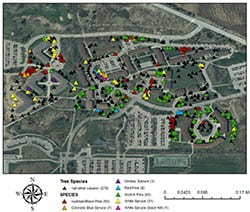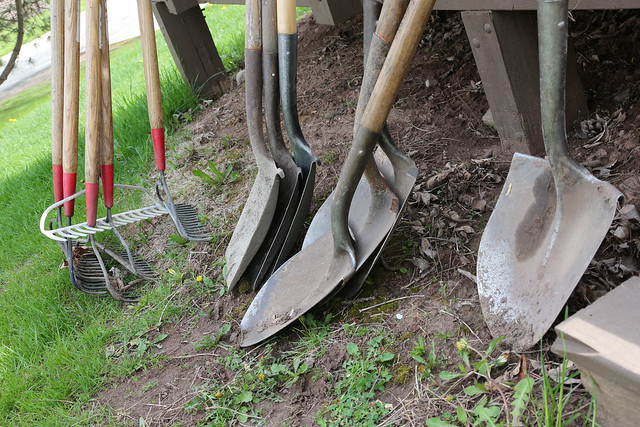Tapping into tree mapping — graduating senior Vlach tracked and coded UWGB trees for senior project

Gina Vlach left a lasting legacy before graduating in spring of 2016 from the University of Wisconsin-Green Bay. The UW‑Green Bay triple major mapped and geocoded every tree in the Residence Life (student housing) area of campus.

Gina Vlach
“Quite simply, I love trees,” said Vlach who did the mapping as part of a senior honors project. “Last spring I was sent an article about the tree mapping that had been done in New York City, and I thought that it would be fascinating to try to replicate it here on campus,” she explains. “Once I started my project, I realized that there was a need for a record of trees to be made and that my project could fill that gap.”
There were two purposes for this project: to determine where additional trees should be planted and to configure which areas of housing are susceptible to tree disease, to aid the university in preparing for threats and pests.
“Not knowing where trees exist or what species they are prevents facilities from properly preparing for threats and addressing them, should the threat impact trees on campus,” she said.
“The inventory Gina did of Residence Life’s tree diversity is important to campus planning for the future,” says UW-Green Bay’s Director of Facilities Management and Planning Paul Pinkston. “Philosophies on planting have changed over time. We are now moving away from a monoculture, where a single species was planted multiple times in an area. Instead, we are planning for plantings of more diverse species so we don’t have, for instance, entire sections wiped out like the recent case with Dothistroma killing Austrian pines. Gina’s work also helps us look at the ages and sizes of plantings so that we have a balance of mature trees and saplings, and different levels of shape and color for visual interest in any given area.”
 Vlach first determined her area of study using a map of the University. After dividing the space into quadrants with pathways as guidelines, she identified all of the trees using a guidebook, and transcribed the information onto a chart, which included location, circumference and diameter. Eventually she obtained a Garmin to generate the longitudinal and latitudinal data and 473 trees were given coordinate data and I.D. numbers and transcribed onto an Excel document. The document was uploaded into an ArcGIS software (cloud-based mapping platform) and was used to provide detailed recommendations and a variety of Geographic Information Systems (GIS) maps that illustrate the areas of concern and the tree species. Her project included a heat map indicating the highest threat level (the highest threat was given to white and green ash trees, because of the likelihood of emerald ash borers infections, for instance). She has presented her work at several campus and regional conferences.
Vlach first determined her area of study using a map of the University. After dividing the space into quadrants with pathways as guidelines, she identified all of the trees using a guidebook, and transcribed the information onto a chart, which included location, circumference and diameter. Eventually she obtained a Garmin to generate the longitudinal and latitudinal data and 473 trees were given coordinate data and I.D. numbers and transcribed onto an Excel document. The document was uploaded into an ArcGIS software (cloud-based mapping platform) and was used to provide detailed recommendations and a variety of Geographic Information Systems (GIS) maps that illustrate the areas of concern and the tree species. Her project included a heat map indicating the highest threat level (the highest threat was given to white and green ash trees, because of the likelihood of emerald ash borers infections, for instance). She has presented her work at several campus and regional conferences.
“I am so pleased with the end result and honored that my work was able to help facilities and the Office of Residence Life select trees to plant this spring and hope that my project will continue to serve as a foundation for tree plantings in the future.”
Eleven new trees were planted in May of 2016 at Residence Life and were funded by a donation from Wisconsin Public Service (WPS) and funds from Residence Life and the UWGB Sustainability Committee.
Gina’s faculty advisor for the project, Prof. David Helpap, said he plans to use Gina’s project as an example moving forward of what an honors project can be modeled after.
“I think the effort, passion, and end-results associated with Gina’s work exemplify an excellent honors project,” said Helpap. “Gina had an interest in a particular topic, she applied the skills she learned in her courses at UWGB to develop research results and policy recommendations and she now will be able to see her project better the UWGB campus. Gina should be incredibly proud of all of the work she completed at every stage of this project.”
Vlach majored in Environmental Policy and Planning, Public Administration and Political Science, with a minor in Environmental Science. She graduated in May 2016 and aspires to return to her hometown to find a job working in either a nonprofit or public sector.
Photo gallery
Click to advance slideshow or view the album on Flickr.

– Story by 2016 graduate Angela Kingsley, photos by Dan Moore, Marketing and University Communication



